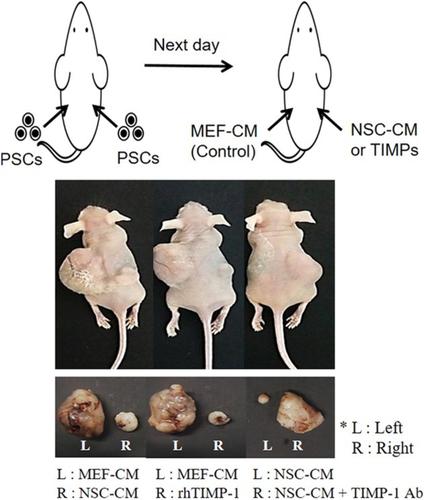当前位置:
X-MOL 学术
›
STEM CELLS
›
论文详情
Our official English website, www.x-mol.net, welcomes your
feedback! (Note: you will need to create a separate account there.)
Tissue inhibitor of metalloproteinase proteins inhibit teratoma growth in mice transplanted with pluripotent stem cells
STEM CELLS ( IF 4.0 ) Pub Date : 2019-12-27 , DOI: 10.1002/stem.3132 Kyung-Ah Choi 1 , Han-Kyul Park 1 , Insik Hwang 1 , Hyesun Jeong 1 , Hang-Soo Park 1 , Ah-Young Jang 1 , Yong Namkung 1 , Donghun Hyun 1 , Seulbee Lee 1 , Byung Min Yoo 2 , Han-Jin Kwon 3 , Ki-Cheon Seol 4 , Jeong-Ok Kim 4 , Sunghoi Hong 1
STEM CELLS ( IF 4.0 ) Pub Date : 2019-12-27 , DOI: 10.1002/stem.3132 Kyung-Ah Choi 1 , Han-Kyul Park 1 , Insik Hwang 1 , Hyesun Jeong 1 , Hang-Soo Park 1 , Ah-Young Jang 1 , Yong Namkung 1 , Donghun Hyun 1 , Seulbee Lee 1 , Byung Min Yoo 2 , Han-Jin Kwon 3 , Ki-Cheon Seol 4 , Jeong-Ok Kim 4 , Sunghoi Hong 1
Affiliation

|
Pluripotent stem cells (PSCs) can serve as an unlimited cell source for transplantation therapies for treating various devastating diseases, such as cardiovascular diseases, diabetes, and Parkinson's disease. However, PSC transplantation has some associated risks, including teratoma formation from the remaining undifferentiated PSCs. Thus, for successful clinical application, it is essential to ablate the proliferative PSCs before or after transplantation. In this study, neural stem cell‐derived conditioned medium (NSC‐CM) inhibited the proliferation of PSCs and PSC‐derived neural precursor (NP) cells without influencing the potential of PSC‐NP cells to differentiate into neurons in vitro and prevented teratoma growth in vivo. Moreover, we found that the NSC‐CM remarkably decreased the expression levels of Oct4 and cyclin D1 that Oct4 directly binds to and increased the cleaved‐caspase 3‐positive cell death through the DNA damage response in PSCs and PSC‐NPs. Interestingly, we found that NSCs distinctly secreted the tissue inhibitor of metalloproteinase (TIMP)‐1 and TIMP‐2 proteins. These proteins suppressed not only the proliferation of PSCs in cell culture but also teratoma growth in mice transplanted with PSCs through inhibition of matrix metalloproteinase (MMP)‐2 and MMP‐9 activity. Taken together, these results suggest that the TIMP proteins may improve the efficacy and safety of the PSC‐based transplantation therapy.
中文翻译:

金属蛋白酶蛋白的组织抑制剂抑制移植多能干细胞的小鼠畸胎瘤的生长
多能干细胞 (PSC) 可以作为无限的细胞来源,用于治疗各种破坏性疾病,如心血管疾病、糖尿病和帕金森病的移植疗法。然而,PSC 移植存在一些相关风险,包括剩余未分化 PSC 形成畸胎瘤。因此,对于成功的临床应用,在移植之前或之后消融增殖的 PSC 是必不可少的。在这项研究中,神经干细胞衍生的条件培养基 (NSC-CM) 抑制了 PSC 和 PSC 衍生的神经前体 (NP) 细胞的增殖,而不影响 PSC-NP 细胞在体外分化为神经元的潜力,并阻止了畸胎瘤的生长体内。而且,我们发现 NSC-CM 通过 PSC 和 PSC-NP 中的 DNA 损伤反应显着降低 Oct4 和 Oct4 直接结合的细胞周期蛋白 D1 的表达水平,并增加了裂解的半胱天冬酶 3 阳性细胞死亡。有趣的是,我们发现 NSC 明显分泌金属蛋白酶 (TIMP)-1 和 TIMP-2 蛋白的组织抑制剂。这些蛋白质不仅抑制了细胞培养中 PSC 的增殖,而且通过抑制基质金属蛋白酶 (MMP)-2 和 MMP-9 的活性,抑制了移植了 PSC 的小鼠的畸胎瘤生长。总之,这些结果表明 TIMP 蛋白可以提高基于 PSC 的移植疗法的疗效和安全性。我们发现 NSCs 明显分泌金属蛋白酶 (TIMP)-1 和 TIMP-2 蛋白的组织抑制剂。这些蛋白质不仅抑制了细胞培养中 PSC 的增殖,而且通过抑制基质金属蛋白酶 (MMP)-2 和 MMP-9 的活性,抑制了移植了 PSC 的小鼠的畸胎瘤生长。总之,这些结果表明 TIMP 蛋白可以提高基于 PSC 的移植疗法的疗效和安全性。我们发现 NSCs 明显分泌金属蛋白酶 (TIMP)-1 和 TIMP-2 蛋白的组织抑制剂。这些蛋白质不仅抑制了细胞培养中 PSC 的增殖,而且通过抑制基质金属蛋白酶 (MMP)-2 和 MMP-9 的活性,抑制了移植了 PSC 的小鼠的畸胎瘤生长。总之,这些结果表明 TIMP 蛋白可以提高基于 PSC 的移植疗法的疗效和安全性。
更新日期:2019-12-27
中文翻译:

金属蛋白酶蛋白的组织抑制剂抑制移植多能干细胞的小鼠畸胎瘤的生长
多能干细胞 (PSC) 可以作为无限的细胞来源,用于治疗各种破坏性疾病,如心血管疾病、糖尿病和帕金森病的移植疗法。然而,PSC 移植存在一些相关风险,包括剩余未分化 PSC 形成畸胎瘤。因此,对于成功的临床应用,在移植之前或之后消融增殖的 PSC 是必不可少的。在这项研究中,神经干细胞衍生的条件培养基 (NSC-CM) 抑制了 PSC 和 PSC 衍生的神经前体 (NP) 细胞的增殖,而不影响 PSC-NP 细胞在体外分化为神经元的潜力,并阻止了畸胎瘤的生长体内。而且,我们发现 NSC-CM 通过 PSC 和 PSC-NP 中的 DNA 损伤反应显着降低 Oct4 和 Oct4 直接结合的细胞周期蛋白 D1 的表达水平,并增加了裂解的半胱天冬酶 3 阳性细胞死亡。有趣的是,我们发现 NSC 明显分泌金属蛋白酶 (TIMP)-1 和 TIMP-2 蛋白的组织抑制剂。这些蛋白质不仅抑制了细胞培养中 PSC 的增殖,而且通过抑制基质金属蛋白酶 (MMP)-2 和 MMP-9 的活性,抑制了移植了 PSC 的小鼠的畸胎瘤生长。总之,这些结果表明 TIMP 蛋白可以提高基于 PSC 的移植疗法的疗效和安全性。我们发现 NSCs 明显分泌金属蛋白酶 (TIMP)-1 和 TIMP-2 蛋白的组织抑制剂。这些蛋白质不仅抑制了细胞培养中 PSC 的增殖,而且通过抑制基质金属蛋白酶 (MMP)-2 和 MMP-9 的活性,抑制了移植了 PSC 的小鼠的畸胎瘤生长。总之,这些结果表明 TIMP 蛋白可以提高基于 PSC 的移植疗法的疗效和安全性。我们发现 NSCs 明显分泌金属蛋白酶 (TIMP)-1 和 TIMP-2 蛋白的组织抑制剂。这些蛋白质不仅抑制了细胞培养中 PSC 的增殖,而且通过抑制基质金属蛋白酶 (MMP)-2 和 MMP-9 的活性,抑制了移植了 PSC 的小鼠的畸胎瘤生长。总之,这些结果表明 TIMP 蛋白可以提高基于 PSC 的移植疗法的疗效和安全性。











































 京公网安备 11010802027423号
京公网安备 11010802027423号